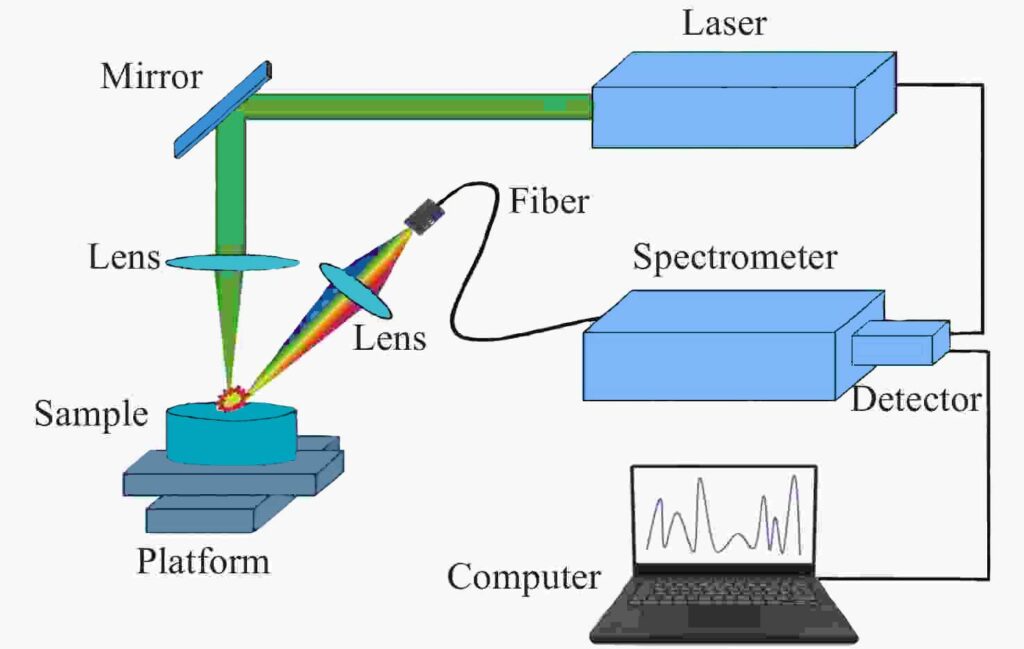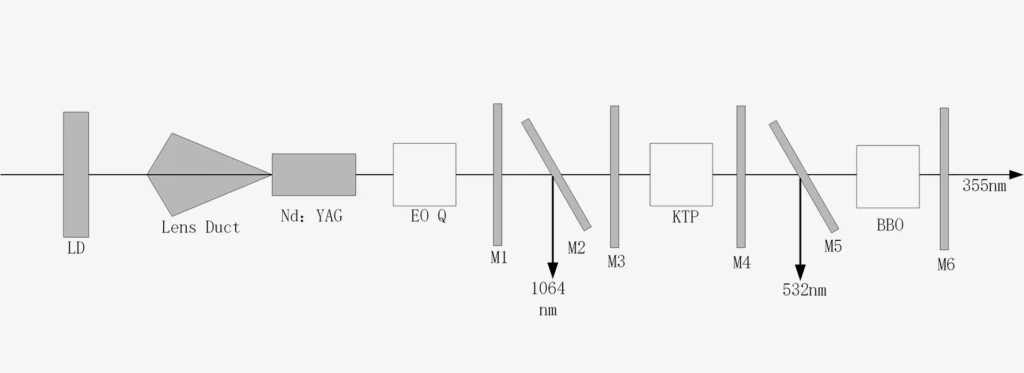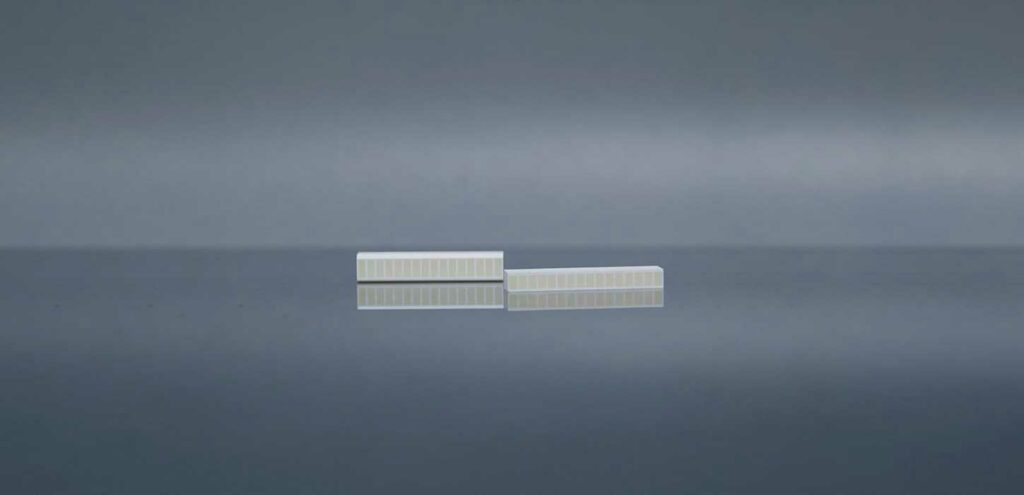Chapter 1: Introduction to Nd YAG Wavelength

Nd YAG lasers are a type of solid-state laser that use a crystal made of neodymium-doped yttrium aluminum garnet as a lasing medium. When the crystal is excited with light or electrical energy, it emits light at a specific wavelength of 1064 nm.
One of the key advantages of Nd YAG lasers is their ability to operate in both pulsed and continuous modes. This allows for a wide range of applications, from medical treatments to industrial cutting and welding.
Nd YAG lasers are also known for their high energy output and excellent beam quality. The high energy output allows for faster and more efficient processing of materials, while the excellent beam quality ensures precise and accurate cutting and welding.
Nd YAG lasers are also highly versatile, as they can be used with a variety of materials including metals, plastics, ceramics, and composites. This versatility has made them an essential tool in a wide range of industries, from aerospace and automotive to medical and scientific research.
Nd YAG lasers can be operated at a variety of power levels, from just a few watts up to hundreds of watts. This flexibility allows for customization of the laser’s power output to suit specific applications.
Another advantage of Nd YAG lasers is their ability to be Q-switched, which means that the laser can be turned on and off rapidly, producing short bursts of high-energy pulses. Q-switching allows for precise control of the laser’s energy output, making it useful for applications such as tattoo removal, laser marking, and laser micromachining.
Nd YAG lasers are also highly efficient, with conversion efficiencies of up to 50%. This means that a large portion of the input energy is converted into laser light, making Nd YAG lasers more energy-efficient than other types of lasers.
Medical Applications Nd YAG lasers have a wide range of medical applications, including laser surgery, dermatology, and ophthalmology. In laser surgery, Nd YAG lasers are used for procedures such as endoscopy, lithotripsy, and ablation of soft tissue. In dermatology, Nd YAG lasers are used for tattoo removal, skin resurfacing, and hair removal. In ophthalmology, Nd YAG lasers are used for procedures such as cataract surgery and glaucoma treatment.
Industrial Applications Nd YAG lasers are widely used in the industrial sector for cutting, welding, and marking of a variety of materials including metals, plastics, and ceramics. Nd YAG lasers are particularly useful for cutting and welding materials that are difficult to work with using other methods. Nd YAG lasers are also used for laser marking and engraving, which is the process of creating permanent markings on materials for identification or branding purposes.
Scientific Applications Nd YAG lasers are widely used in scientific research for a variety of applications, including laser spectroscopy, laser ablation, and laser-induced breakdown spectroscopy. Nd YAG lasers are particularly useful for studying the properties of materials and molecules, as their high energy output and precise control allow for precise and accurate measurements.
In conclusion, Nd YAG wavelength offers a powerful and versatile tool for a wide range of applications. Its high energy output, excellent beam quality, versatility, efficiency, and Q-switching capabilities make it an essential tool for professionals across a variety of industries and fields. With continued advancements in technology, the applications of Nd YAG lasers are likely to expand even further in the future.
Chapter 2: Medical Applications of Nd YAG Wavelength
Nd YAG lasers have numerous medical applications, thanks to their ability to penetrate deep into tissue while minimizing damage to surrounding areas. In this chapter, we will explore some of the most common medical applications of Nd YAG lasers.
Laser Surgery Nd YAG lasers are widely used in laser surgery due to their ability to penetrate deep into tissue while minimizing damage to surrounding areas. In laser surgery, Nd YAG lasers are used for procedures such as endoscopy, lithotripsy, and ablation of soft tissue.
Endoscopy is a minimally invasive procedure that allows doctors to view and perform procedures inside the body using a small camera and a flexible tube. Nd YAG lasers are used in endoscopy to remove tumors and treat other conditions without the need for traditional surgery.

Lithotripsy is a procedure that uses shock waves to break up kidney stones, allowing them to be passed more easily. Nd YAG lasers are used in lithotripsy to help break up larger stones that cannot be treated using shock waves alone.
Ablation of soft tissue involves removing or destroying unwanted tissue, such as tumors or lesions, using a laser. Nd YAG lasers are particularly useful for this procedure due to their ability to penetrate deep into tissue while minimizing damage to surrounding areas.
Dermatology Nd YAG lasers are widely used in dermatology for a variety of applications, including tattoo removal, skin resurfacing, and hair removal.
Tattoo removal involves using a laser to break up the pigment in the tattoo ink, allowing the body to absorb and eliminate it. Nd YAG lasers are particularly useful for tattoo removal due to their ability to penetrate deep into the skin while minimizing damage to surrounding areas.
Skin resurfacing involves removing the top layer of skin to reduce the appearance of wrinkles, scars, and other imperfections. Nd YAG lasers are used in skin resurfacing to promote collagen production, which can help improve the appearance of the skin.
Hair removal involves using a laser to target and destroy hair follicles, preventing hair growth. Nd YAG lasers are particularly useful for hair removal on darker skin types, as they are less likely to cause damage to the surrounding skin.
Ophthalmology Nd YAG lasers are also used in ophthalmology for a variety of procedures, including cataract surgery and glaucoma treatment.
Cataract surgery involves using a laser to break up the clouded lens of the eye, allowing it to be removed and replaced with an artificial lens. Nd YAG lasers are particularly useful for this procedure due to their ability to penetrate the eye while minimizing damage to surrounding areas.
Glaucoma treatment involves using a laser to reduce the amount of fluid in the eye, which can help reduce intraocular pressure and prevent damage to the optic nerve. Nd YAG lasers are used in glaucoma treatment to create a small hole in the iris, allowing the fluid to drain more easily.
Overall, Nd YAG lasers offer a powerful and versatile tool for a wide range of medical applications. Their ability to penetrate deep into tissue while minimizing damage to surrounding areas makes them an essential tool for medical professionals across a variety of fields. As technology continues to advance, the applications of Nd YAG lasers in medicine are likely to expand even further in the future.
Chapter 3: Industrial Applications of Nd YAG Wavelength
Nd YAG lasers are widely used in the industrial sector for cutting, welding, and marking of a variety of materials including metals, plastics, and ceramics. In this chapter, we will explore some of the most common industrial applications of Nd YAG lasers.
Cutting and Welding Nd YAG lasers are particularly useful for cutting and welding materials that are difficult to work with using other methods. Their ability to generate high-energy pulses in a short amount of time makes them ideal for precise cutting and welding of metals, plastics, and ceramics.

Nd YAG lasers are widely used in the automotive industry for cutting and welding parts such as engine components and body panels. They are also used in the aerospace industry for cutting and welding parts such as turbine blades and aircraft components.
In the electronics industry, Nd YAG lasers are used for cutting and welding of microelectronic components, such as circuit boards and semiconductor devices. Nd YAG lasers are also used in the medical device industry for cutting and welding of small medical devices, such as stents and catheters.
Laser Marking and Engraving Nd YAG lasers are also used for laser marking and engraving, which is the process of creating permanent markings on materials for identification or branding purposes. Nd YAG lasers are particularly useful for marking and engraving metals, plastics, and ceramics, as they can create high-contrast markings with very fine detail.
In the automotive industry, Nd YAG lasers are used for marking and engraving of parts such as engine components and vehicle identification numbers. In the electronics industry, Nd YAG lasers are used for marking and engraving of microelectronic components, such as circuit boards and semiconductor devices.
Nd YAG lasers are also used in the jewelry industry for marking and engraving of precious metals, such as gold and silver. They are also used in the aerospace industry for marking and engraving of aircraft components.
Micromachining Nd YAG lasers are also used for laser micromachining, which is the process of creating very small features on materials. Nd YAG lasers can be used to create features as small as a few microns, making them useful for creating microelectronic components, microfluidic devices, and other microscale structures.
In the medical device industry, Nd YAG lasers are used for laser micromachining of small medical devices, such as stents and catheters. In the electronics industry, Nd YAG lasers are used for laser micromachining of microelectronic components, such as microfluidic devices and microelectromechanical systems (MEMS).
Nd YAG lasers are also used in the scientific research field for laser micromachining of materials for the creation of microscale structures, such as photonic crystals and micro-optics.
Overall, Nd YAG lasers offer a powerful and versatile tool for a wide range of industrial applications. Their ability to generate high-energy pulses in a short amount of time makes them ideal for precise cutting, welding, marking, and micromachining of a variety of materials. As technology continues to advance, the applications of Nd YAG lasers in industry are likely to expand even further in the future.
Chapter 4: Scientific Applications of Nd YAG Wavelength
Nd YAG lasers are widely used in scientific research for a variety of applications, thanks to their high power and ability to generate short pulses of light. In this chapter, we will explore some of the most common scientific applications of Nd YAG lasers.
Spectroscopy Nd YAG lasers are widely used in spectroscopy, which is the study of the interaction between light and matter. Nd YAG lasers are particularly useful for spectroscopy due to their ability to generate short pulses of light, which can be used to measure the absorption and emission spectra of materials.
In materials science, Nd YAG lasers are used for Raman spectroscopy, which is a technique for identifying materials based on their unique vibrational spectra. Nd YAG lasers are also used for laser-induced breakdown spectroscopy (LIBS), which is a technique for identifying the elemental composition of materials based on the light emitted when they are heated by a laser.

In the field of chemistry, Nd YAG lasers are used for time-resolved spectroscopy, which is a technique for measuring the dynamics of chemical reactions over very short time scales. Nd YAG lasers are also used for fluorescence spectroscopy, which is a technique for studying the properties of fluorescent materials.
Optical Physics Nd YAG lasers are also widely used in the field of optical physics, which is the study of the behavior of light and its interactions with matter. Nd YAG lasers are particularly useful for optical pumping, which is the process of raising the energy level of atoms or molecules using light.
Nd YAG lasers are used in the field of quantum optics for generating entangled photon pairs, which are used in quantum communication and other applications. Nd YAG lasers are also used for generating high-intensity pulses of light, which can be used for studying the behavior of light in extreme conditions.
Nd YAG lasers are also used in the field of nonlinear optics, which is the study of the behavior of light in nonlinear media. Nd YAG lasers are particularly useful for generating high-intensity light beams that can be used to study phenomena such as self-focusing, self-phase modulation, and harmonic generation.
Biomedical Applications Nd YAG lasers are also used in biomedical research for a variety of applications, including imaging and therapy. Nd YAG lasers are particularly useful for biomedical applications due to their ability to penetrate deep into tissue while minimizing damage to surrounding areas.
In the field of ophthalmology, Nd YAG lasers are used for photodisruption, which is a technique for treating conditions such as glaucoma and retinal detachment. Nd YAG lasers are also used for photocoagulation, which is a technique for treating conditions such as diabetic retinopathy.
In the field of neuroscience, Nd YAG lasers are used for optogenetics, which is a technique for controlling the activity of neurons using light. Nd YAG lasers are also used for two-photon microscopy, which is a technique for imaging deep within living tissue.
Overall, Nd YAG lasers offer a powerful and versatile tool for a wide range of scientific applications. Their ability to generate high-energy pulses of light makes them ideal for spectroscopy, optical physics, and biomedical research. As technology continues to advance, the applications of Nd YAG lasers in science are likely to expand even further in the future.
Chapter 5: Advantages of Nd YAG Wavelength
Nd YAG lasers offer several advantages over other types of lasers due to their unique characteristics. In this chapter, we will explore some of the most significant advantages of Nd YAG lasers.
High Power and Energy Nd YAG lasers are capable of producing high-power and high-energy laser beams, making them ideal for a wide range of applications. Their ability to generate high-energy pulses of light in a short amount of time makes them useful for precision cutting, welding, and drilling of materials.
The high power and energy of Nd YAG lasers also make them useful for scientific applications such as spectroscopy, where high-energy pulses of light are required to generate accurate measurements. Additionally, Nd YAG lasers are used in the field of biomedicine for applications such as photodisruption and photocoagulation, which require high-energy pulses of light.
Stability and Reliability Nd YAG lasers are known for their stability and reliability, which is why they are widely used in industrial and scientific applications. Nd YAG lasers can operate continuously for long periods of time without experiencing significant fluctuations in power or energy output, making them ideal for industrial applications such as cutting and welding.
Nd YAG lasers are also highly reliable, meaning they are less likely to break down or require repairs than other types of lasers. This reliability is essential in scientific applications where researchers need to rely on accurate measurements and data.
Versatility Nd YAG lasers are highly versatile and can be used for a wide range of applications due to their ability to operate in a variety of modes. They can be operated in continuous-wave mode, which allows for steady output of energy and power, or in pulsed mode, which allows for high-energy pulses of light.
Nd YAG lasers can also be used for a variety of applications due to their ability to generate a range of wavelengths. The fundamental wavelength of an Nd YAG laser is 1.064 micrometers, but it can also generate second, third, and fourth harmonics at 532, 355, and 266 nanometers, respectively.

Compact Size Nd YAG lasers are relatively compact in size compared to other types of lasers, making them easier to integrate into existing systems. This makes them ideal for industrial applications, where space is often at a premium.
The compact size of Nd YAG lasers also makes them ideal for scientific applications where multiple lasers may be required for a single experiment. Nd YAG lasers can be easily integrated into experimental setups, allowing researchers to perform multiple measurements simultaneously.
Low Cost of Ownership The low cost of ownership of Nd YAG lasers is another significant advantage. Nd YAG lasers are highly reliable, which means they require less maintenance and repairs compared to other types of lasers. Additionally, Nd YAG lasers have a long lifespan, which means they do not need to be replaced as frequently as other types of lasers.
Overall, Nd YAG lasers offer several advantages over other types of lasers, including high power and energy, stability and reliability, versatility, compact size, and low cost of ownership. These advantages make Nd YAG lasers an ideal choice for a wide range of applications in industry, science, and medicine.
Chapter 6: Future Directions for Nd YAG Wavelength
The Nd YAG wavelength has proven to be a valuable tool in a wide range of applications, from industrial processes to medical procedures. As technology continues to advance, the future of Nd YAG lasers is bright, with new applications and improvements in efficiency and performance on the horizon.
Improvements in Efficiency One area of focus for future development of Nd YAG lasers is increasing their efficiency. While Nd YAG lasers are already highly efficient, there is always room for improvement. Researchers are exploring ways to increase the efficiency of Nd YAG lasers by improving the materials used in their construction, as well as by optimizing their designs.
One approach to improving the efficiency of Nd YAG lasers is to use novel materials in their construction. For example, researchers have explored the use of ceramic materials such as Yttria-stabilized zirconia (YSZ) as an alternative to traditional crystal materials. These materials have the potential to increase the efficiency of Nd YAG lasers by reducing heat loss during operation.

Another approach to improving efficiency is to optimize the design of Nd YAG lasers. Researchers are exploring ways to improve the coupling efficiency between the laser and the target material, as well as to reduce the amount of energy lost to heat. These improvements could lead to more efficient Nd YAG lasers that are capable of generating higher power output.
New Applications As technology continues to advance, new applications for Nd YAG lasers are likely to emerge. One area of interest is the use of Nd YAG lasers in quantum technologies, such as quantum communication and quantum computing. Nd YAG lasers have the potential to generate high-quality single photons, which could be used for quantum communication and quantum key distribution.
Nd YAG lasers may also find new applications in environmental sensing and monitoring. For example, Nd YAG lasers could be used for remote sensing of greenhouse gases and other atmospheric pollutants, or for the detection of oil spills in the ocean.
Finally, Nd YAG lasers may find new applications in the field of energy production. Nd YAG lasers could be used for laser ignition of fossil fuels, which could lead to more efficient and cleaner combustion. Nd YAG lasers could also be used for laser-induced fusion, which has the potential to provide a nearly limitless source of clean energy.
Conclusion The Nd YAG wavelength has proven to be a valuable tool in a wide range of applications, from industrial processes to medical procedures. As technology continues to advance, the future of Nd YAG lasers is bright, with new applications and improvements in efficiency and performance on the horizon.
Improvements in efficiency, new applications in quantum technologies, environmental sensing and monitoring, and energy production are just a few of the areas where Nd YAG lasers are likely to find new applications in the future. The Nd YAG wavelength is a versatile and powerful tool that will continue to play an important role in science and industry for many years to come.

Frank
Frank graduated from the University of Shanghai for Science and Technology, majoring in optics. As a technical engineer at Crylink Company, he deeply understands crystal materials and laser components.
Related Video(s) with this Article
Related Product(s) with this Article
Related Application(s) with this Article

